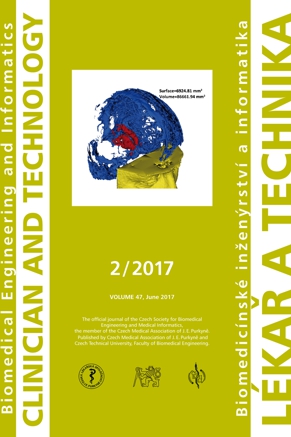/GD-TRACKER/ A SOFTWARE FOR BLOOD-BRAIN BARRIER PERMEABILITY ASSESSMENT
Keywords:
blood-brain barrier, MRI, Gd-DTPA, permeability, stroke, epileptogenesis, MATLAB, freeware, Gd-TrackerAbstract
Epilepsy is chronic neurological disease characterized by occurrence of spontaneous recurrent seizures affecting approximately 1% of people. One of the most common causes of epilepsy in adults is a stroke. The precise mechanism of development of vascular epilepsy is not known, and thus no reliable biomarker of postischemic epileptogenesis currently exists. Blood-brain barrier (BBB) impairment is phenomenon observed in several pathologies including stroke after which epilepsy often develops. Blood components such as albumin or thrombin have been experimentally shown to possess the capacity to increase excitability which results in seizures and epileptogenesis. We hypothesize that severity of the BBB breakdown during first weeks after the stroke can be used as a biomarker of postischemic epileptogenesis. This paper describes free MATLAB based software /Gd-Tracker/ and methodology developed for assessment of BBB permeability from magnetic resonance (MR) scans based on statistical voxel to voxel comparison of sequences with and without Gd-DTPA contrast. This software allows to evaluate extent and magnitude of impaired BBB region and thus serve as a tool for visualization and quantification of BBB breakdown.Downloads
Published
Issue
Section
License
Copyright (c) 2017 David Kala, Jan Svoboda, Andrej Litvinec, Antonín Pošusta, Jiří Lisý, Vlastimil Šulc, Aleš Tomek, Petr Marusič, Přemysl Jiruška, Jakub Otáhal

This work is licensed under a Creative Commons Attribution 4.0 International License.
Authors who publish with this journal agree to the following terms:
- Authors retain copyright and grant the journal right of the first publication with the work simultaneously licensed under a Creative Commons Attribution License (https://creativecommons.org/licenses/by/4.0/) that allows others to share the work with an acknowledgment of the work's authorship and initial publication in CTJ.
- Authors are able to enter into separate, additional contractual arrangements for the non-exclusive distribution of the journal’s published version of the work (e.g., post it to an institutional repository or publish it in a book), with an acknowledgment of its initial publication in this journal.
- Authors are permitted and encouraged to post their work online (e.g., in institutional repositories or on their website or ResearchGate) prior to and during the submission process, as it can lead to productive exchanges.
CTJ requires that all of the content of the manuscript has been created by its respective authors or that permission to use a copyrighted material has been obtained by the authors before submitting the manuscript to CTJ. CTJ requires that authors have not used any copyrighted material illegally, as for example a picture from another journal or book, a photo, etc. It is the author’s responsibility to use only materials not violating the copyright law. When in doubt, CTJ may ask the authors to supply the pertinent permission or agreement about the use of a copyrighted material.
The opinions expressed in CTJ articles are those of authors and do not necessarily reflect the views of the publishers or the Czech Society for Biomedical Engineering and Medical Informatics.


